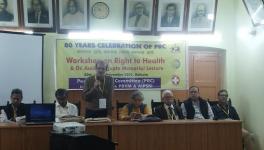Quest for ‘Gay Gene’ is Bound to Face Scientific and Ethical Questions

The quest for finding the biological basis of sexual orientation has been a much debated topic, especially finding out how genes influence homosexuality has sparked debates for not less than a quarter century. Nevertheless, geneticists still continue with their efforts to decipher the genetic linkage of sexuality, and the recent study published in Science is claimed to be largest one ever done in this direction. However, it raises scientific and ethical questions.
This latest reported study claims to have figured out four genetic variants among the people who had at least one same- sex experience. They identified the four variants in chromosomes 7, 11, 12 and 15. Genetic variants in this context would refer to the differences in the DNA sequence between the heterosexual group and the group of having same-sex experience.
Andrea Ganna of the Broad Institute, US, and his colleagues examined data from hundreds of thousands of people whose DNA and behavioural information were collected in UK Biobank study and the private genetic firm 23andMe, the two large genetic surveys of the world. The team analysed DNA markers from the people who answered either “yes” or “no” to the question about their sexual orientation. The question posed was—“Have you ever had sex with someone of the same sex?” They could find that among the individuals they interviewed and whose DNA was analysed, 450,939 people were exclusively heterosexual and 26,890 people reported at least one same-sex experience.
STUDIES ON GENETIC BASIS OF SEXUALITY AND SCIENTIFIC QUESTIONS
Most of the studies to find out specific genes expressed in the homosexual population are silent on the heterosexual population and vice-versa. The findings of the genetic variants and the effort to link it to sexual orientation, therefore, pose many questions.
First, the genetic variants claimed to be related to sexual behaviour may also be related to other traits. For example, in Ganna’s study itself, among the four genetic variants found, one present on chromosome 15, as a cluster of DNA, was previously found to be linked to male baldness and another variant found on chromosome 11 is also linked to olfactory receptors.
Can a definitive conclusion be drawn that different genetic expression patterns in people of different sexual behaviour is the basis of their sexual behaviour? The answer is ‘no’. Gene expression is more complicated than the imagination of linking it directly to behaviour.
There are necessarily many pathways that will come in between genes and behaviour, and even more, when we talk about any behaviour that consists both of thinking and behaving, for example, the sexual choices people make.
Genes primarily provide the guidelines for another nitrogenous molecule, called RNA. A particular pattern of RNA is expressed in response to the signal a gene sends to it. The RNA, in turn, guides the pattern in which a sequence of amino acids would form, which ultimately forms a protein. Different protein molecules in different forms interact synchronously that may influence a behaviour. Again, epigenetic mechanisms play a huge role in giving rise to a particular trait or, for that matter, behaviour. The genes present in a homosexual person also are present in a heterosexual person. What genes will express and confer their effect on which trait, is dependent on the cellular environment.
Tracing back history, the most complicated and debated genetic study has probably been that of the study done by Dean Hamer’s group. The study done in 1993 claimed to have shown statistically that genes influencing sexual behaviour may reside in the q28 region of the X chromosome. The X chromosomes are the sex chromosomes; females have two copies of X chromosomes and males only one copy of this chromosome. So, a mother passes only one copy her X chromosomes to her son. But later on, the same study couldn’t be reproduced in a Canadian study with similar experimental set up.
Nicole Ferraro, a biomedical informatics graduate student of Stanford University, US, and her fellow biomedical sciences graduate student Kameroon Rodrigues pose serious questions regarding the latest study. In her comment to Science magazine, Rodrigues said, “It just seems like there’s no benefit that can come from this kind of study, only harm.” They put forward the view that studies of this kind can be used to stigmatise the members of LGBTQ community.
ETHICAL QUESTIONS
Our contemporary societies are still biased against gays, lesbians and bisexuals. Many countries still criminalise homosexuality. In the prevailing homophobic environment, how far can one ensure that studies of these kinds will not be used against the dignity of the people practicing homosexuality?
The inhuman therapeutic approaches applied on homosexual people for the aversion of their sexual orientation is still in practice. The ‘conversion therapies’ might include electric shock treatment, hormonal therapies, genital mutilation and brain surgeries. Many of these therapeutic efforts have destroyed the lives of otherwise healthy people. Now the screams of genetic findings under the guise of scientific endeavours will leave the space of further discrimination in an already homophobic world. Moreover, genetic linkages of homosexuality may also pave the way for searching genetic pre-disposition of homosexuality in pre-natal conditions.
Further, the issue of value-neutrality of the people that perform these kinds of studies are also questionable. In the first place, the context in which the interest in sexual orientation arises, has to be considered. Homophobia still exists in almost all societies within which sexual orientation researches are conducted. In this situation, the scientists that conduct these studies influence both the questions they ask and the hypotheses they imagine. Given this, how far can one be sure that the sexual orientation research of any scientist will escape homophobia?
Get the latest reports & analysis with people's perspective on Protests, movements & deep analytical videos, discussions of the current affairs in your Telegram app. Subscribe to NewsClick's Telegram channel & get Real-Time updates on stories, as they get published on our website.
























